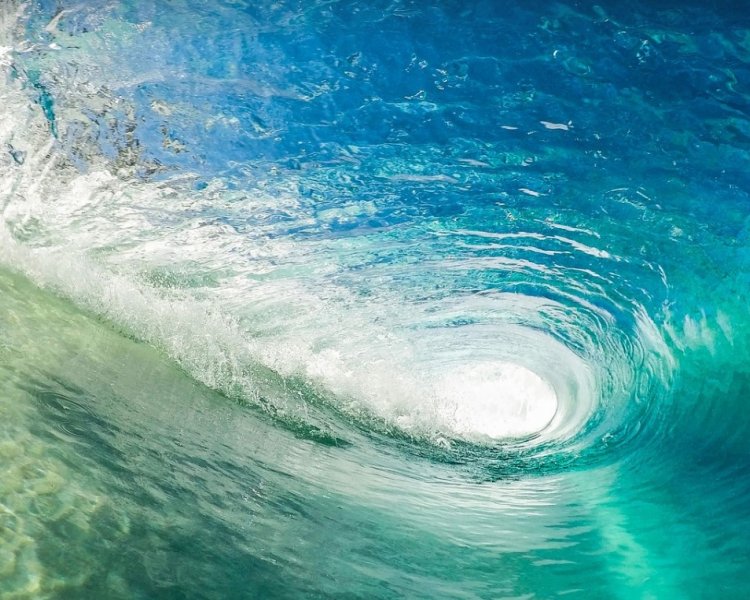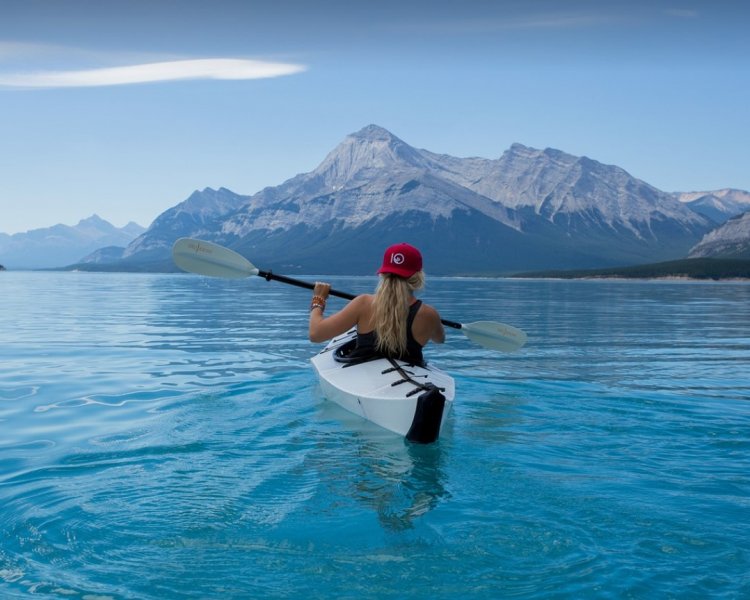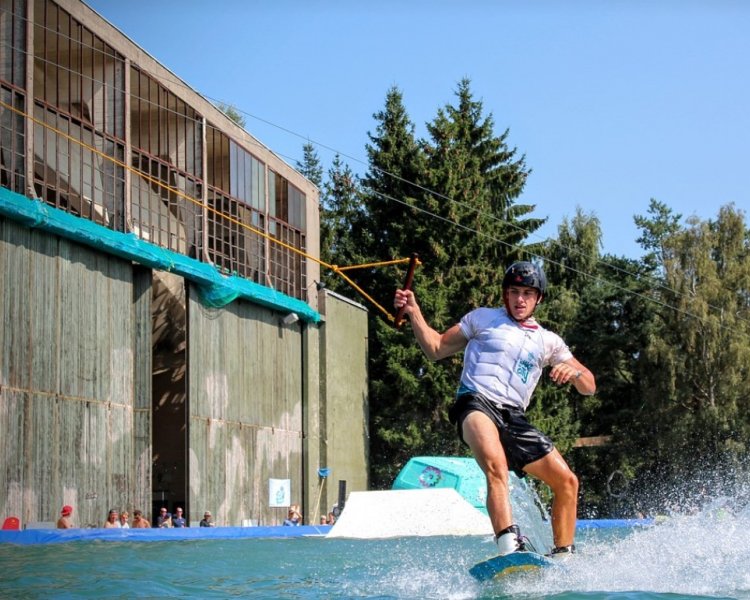What Is Skurfing? Ultimate Skurfing Guide (Easy Read)

There are many reasons for a sport to become extinct or just forgotten, such as better versions being invented, changes in technology, cultural changes, etc.
In the mid-80s, a new discipline called skurfing came to take over the world of water sports. Or maybe not. Let’s take a look at what happened.
What is Skurfing? Skurfing is a tow sport similar to wakeboarding or water skiing but uses a shorter version of a surfboard instead. The board has two foot-straps and the rider is holding onto the rope the whole ride, unlike wake surfing. Skurfing is considered the precursor of the modern wakeboarding.
Although very popular in the 80s and the 90s, skurfing’s interest plummeted when the twin-tipped wakeboards entered the market.
Nowadays, skurfing is considered a recreational activity for nostalgics more than a sport. If you happen to be one of those nostalgics or simply curious about skurfing, take a look into the following article.
Read Also: Is Wakeboarding Dangerous?
What is Skurfing?
In the mid-80s, surfing inspired offshoot of waterskiing called “skurfing” started to appear in lakes and rivers around the USA and Australia. The same boat and tow-rope were used, but instead of water skis, riders would stand on small surfboards and carve the wake that waterskiers would avoid.
Origins
Surfing has always been the most beloved activity for sea lovers. It is hard to put into words the excitement of riding a wave, feeling that deep connection only surf can deliver. But what can we do when the ocean is flat and there are no waves to ride?
When necessity kicks in, people get creative and come up with brilliant ideas. For those flat days with no waves, surfers experimented by being pulled by boats, jet skis, or even trucks on the shoreline!
Skurfing was achieved by having your friends pull you behind a boat on a line that was attached to a handle the skurfer would hold.
While the boat towed the board he or she would attempt carving moves very similar to that of a traditional surfer in the boat’s wake.
It is intriguing how the activity of using a motorized vehicle to tow behind the surfer on the board started to influence the industry of water sports in an interesting way. Due to this new fashion, boards began to shorten in their style and size and these shorter surfboards became very popular.
Welcome to the era of water skurfing.
First Designs
Common features of the early designs of water skurfing boards:
- Back in the day, people used traditional surfboards when being towed by the boat.
- In the beginning, there were no bindings and no straps, making it difficult for the riders to stand up on the board.
- The board was more designed as a small surfboard that could be pulled behind a boat, initially having one large fin on the backside of the board. With only this fin it was hard for the board to navigate around the water.
The Skurfer and The Redline
Back in 1985, two great minds thought alike. They were the minds of Southern California native Tony Finn and Texas native Jimmy Redmon, who separately and simultaneously thought along the same wavelength to create the foundation for what would eventually evolve into a globally renowned sport.
Looking for alternatives to waterskiing and surfing, the two created waterboards that could essentially “surf” the wake behind a boat: “The Skurfer” and the “Redline”.
The Skurfer |
The Redline |
|
|
Both enthusiasts came up with one of the ideas that would change the course of water sports: foot straps bindings were attached to the boards.
Main benefits of having bindings on the board:
- The boards would have now a higher balance and a way for the rider to stay on top during even the worst conditions.
- Thanks to this revolutionary device, it was now possible to perform bigger “airs” -moments where the rider could surf the wake and achieve high-flying results-.
- The spectacularity of the sports increased as the tricks were more impressive. Therefore, the popularity increased as the public was more willing to pay to see such a spectacle.
Although revolutionary when they were introduced to the market, both designs had flaws that were crucial for its further modification and creation of new boards that would result in what we know as wakeboards today.
Main challenges both designs were facing:
- It required excessive energy to get them up and planing on the surface of the water. Due to the high buoyancy and very narrow design, it was hard for the riders to come on top, as the rider was highly unbalanced.
- The sport at a high level was restricted to very strong individuals only. Due to the amount of energy required to pull off deep water starts, the best competitors had to be incredibly strong. This factor made the competitive sport accessible to not so many.
- Lack of innovation over the years. The original design of the boards stayed the same for many years, and it was mainly surviving due to Tony’s tireless efforts to excite people about the product.
Both Tony Finn and Jimmy Redmon met by chance when they were at a trade show. They happened to be next to each other booths, and their relationship would change the industry of watersports.
In 1991, Finn and Redmon joined forces and started Waketech. After much research, testing and innovation, in 1993 they invented the first twin-tip board, which would change the sport forever. This modification is considered a game-changer into the creation of a new sport: wakeboarding.
How to Start Skurfing Step by Step
Skurfing is as physically demanding -if not more- as water skiing or wakeboarding, as a result of the strength required to keep a balanced stance while holding the rope. Therefore, a minimum level of strength and physical condition will be required in order to enjoy the sport to the fullest.
If you have some experience skiing or wakeboarding, obviously that helps, especially on the latter: getting up on a skurfboard is pretty similar to getting up on a wakeboard.
There are multiple techniques you can use to learn how to skurfboard. I will be sharing the method I used when started to ride my first waves some years ago. This technique has been successful for some of my friends, who same as most of you, were first-timers when approaching skurfing.
The following steps will help you through your quest to master the art of skurfing. Good luck!
Find the right boat.
Choosing the right sports boat for you will depend on the activities you plan to use your boat for. Therefore, to maximize the time you will be spending in the water, you will have to find the right boat with the right features.
In this case, we will be talking about the best boat for skurfing.
Generally speaking, it is safe to say that any boat designed for wakeboarding will be suitable for skurfing. As we have talked more in-depth in this article, other sports such as wake surfing will require different boats with different features.
Within the main features that will make a good boat for skurfing we find the following:
- The tower. Same as in wakeboarding, the tower allows the skurfer to gain a bit of extra air for jumping wakes and completing tricks. The high tow point gives the rider more control and makes it easier to jump up onto the board. The tower is normally made of stainless steel or aluminum tubing.
- Inboard V-drive powered boats. Due to the engine’s placement -backward in the rear of the boat- the weight will be higher in the rear, producing larger wakes.
- Ballast tanks. When skurfing, riders really appreciate large wakes to perform air tricks and spins. Some boats are designed with tanks that can be filled with water to tip the rear of the boat so the wakes generated will be higher.
- Cruise control. In water sports, good drivers that can maintain a stable speed are not that easy to find. Cruise control makes it easier for the driver and safer for the rider, as this feature will prevent the boat from pulling and will give a smoother ride.
Get the Right Board
Back in 1985, the Southern Californian Tony Finn introduced a revolutionary new board called “The Skurfer”. By inventing that board, Tony had also invented a new modality: skurfing.
The skurfer was narrow, long, with a rounded tail and pointed nose, and unlike the wakeboards now, includes only one surfboard-like fin and very buoyant design.
Nowadays, very few options are available in the market when it comes to skurfing. And from those available, the majority of them are second-hand items.
Following there is a list of the main features of a skurfboard:
- Small surfboard-like.
- Large fin on the backside of the board.
- High buoyancy due to its surfboard shape and its core material.
Due to scarcity, we are left with no other option than buying -if we can find any- a second-hand board we can find on the Internet.
The Rope
Not many people give the importance that deserves the choice of rope when practicing water sports. But it is indeed an important aspect.
Generally speaking, ropes for skurfing are thinner and longer than wakesurfing ropes, for example.
As a piece of advice, we would recommend the use of shorter ropes when you first start skurfing. The use of a shorter rope often makes it easier for beginners to stand up. Longer ropes allow more advanced riders to get more speed and air for tricks, but we are not there yet.
As a rule of thumb, the length of a beginner’s rope for skurfers should be somewhere between 30 and 50 feet (9,1m or 15,2m).
A Life Jacket or PFD is a Must
I know. You are picturing yourself pulling off the coolest trick you can think of, and probably a flotation device does not fit very well into that Instagram picture. As lame as it might seem to many, wearing a vest or PFD (Personal Flotation Device) is absolutely necessary for safety purposes.
But I have good news for you. Nowadays, there are many options in the market so you can be wearing a totally functional vest and yet being discrete.
Determine Your Stance: Regular or Goofy?
Okay, so now that we are well equipped and ready to go, it is time to figure out our stance.
If you are well versed in sports like surfing, skateboarding or snowboarding you might know it already, but let’s explain the concept for those who don’t know what that means.
Basically, the preferred stance for a rider is the way he or she feels more comfortable with when riding in a sliding sports.
There are two types of stances, depending on which foot is placed in front:
Regular |
Left foot as your front foot |
Goofy |
Right foot as your front foot |
Okay, so now that we all know what are talking about, it is time to find the best way to determine the most natural stance to us. Some people wrongly assume that if you are right-handed you will be regular. But that assumption is simply not true, as I have met many right-handed goofies.
Two ways to find out your preferred stance:
“The Push”. This is probably the most known technique of them all.
This is how you do it:
Stand still with both feet together and simply ask somebody to slightly push you from your back -hard enough to lose your balance-. Whichever foot you put forward to prevent yourself from falling, will determine your stance preference.
- If the left foot came forward, it means you are a regular.
- If it was the right foot instead, you are a goofy.
Preferred turning side. This way of finding out might be helpful if you don’t have anybody around to push you.
When driving a bike, motorbike or even a car, we all have a side we feel safer turning to. Whichever direction you see yourself feeling more comfortable in will determine your stance.
As well as “The Push” technique, if the answer is left, you will be a regular, and if right, goofy will be your stance.
Getting Up
So now we are in the water, with the right board, and out feet place in the right position and ready to roll.
After giving the signal to the driver that you are ready, the boat starts driving away and the rope starts stretching. Getting up time!
When skurfing, there are mainly two ways to get into a stand-up position:
The wakeboarding position.
For this type of start, place the board perpendicular to the rope and between you and the boat. Then, lay on your back and put your feet onto the board, parallel to the board’s direction.
Remember to put your preferred foot on the side you want to surf first. Your back foot should be close to the rear end of the board and your front foot should be somewhere near the middle lengthwise.
It is important that you let the boat pull you out, focusing on your legs work instead of your upper body.
Be patient -there is no rush to pull yourself out-, keep your arms straight, your knees bent and let the board come underneath your body so that you can easily ride above it. Then, stand up slowly as the tail of the board digs in and starts to get on the surface.
The deepwater position.
This starting position is basically slightly standing on top of the board while it is underwater. This method is a little bit more technical, increasing its difficulty.
First, you start pushing the board beneath yourself in the water, so your feet will be already on a standing position on top of the board.
As the line starts to tighten and the boat pulls you out, it will allow your knees to come up a little bit and slowly begin the stand. It is highly advisable to practice it without the rope, only with the skurfboard, as it can be difficult.
Turning
Congratulations, now you are up and riding!
Now that you have come this far, it is time to go a bit further and learn how to turn, brake and speed up.
The fundamentals of turning in skurfing are a blend between surfing and wakeboarding. It all comes down to a combination of weight placement and pointing your board towards the direction you want to go to.
As a rule of thumb, if we want to move to our left, for example, we should push our heels into the board and point our board towards the left, starting with our head and our shoulders.
Alternatively, if we wish to surf to our right side, the pressure should be applied at the top of our feet. Simultaneously, our head and shoulders should aim towards the right side, and eventually, the board will follow.
Also, when riding the wake, if we want to surf faster and bring yourself closer to the boat, just lean forward and try to reach your front arm towards the boat. If you want to reduce the speed instead, just put more weight on the back foot and you will see yourself getting away from the boat.
Practice
The best part about skurfing is that practicing is fun, and taking a spill is less punishing than other sports like skateboarding or snowboarding.
As in many other sports, try to go skurfing with people better than you. By learning from people that are more advanced, you will improve a lot faster and on top of that, you will have a nice time sharing your hobby with other skurfers.
8 Skurfing Tips to Perform Like a Pro in No Time
- Skurfer placement behind the boat
If you are a beginner and your starting position is directly behind the boat, you can end up on top of the wake and will have to surf down, which can be harder than starting from the side.
Therefore, It is best to set the skurfer up at a 45-degree angle off the stern of the boat instead of directly behind the boat. By setting up this angle it is easier for the rider to continue surfing after they stand up on the board because the wake builds up behind them.
2. Let the boat do all the work
It is very important not to fight against the boat and push against the water. Instead, you want to slowly stand up and let the boat do the work for you.
I recommend you hold the rope with two hands and place your feet on the board. Then you should lift the handle up as it is positioned right between your knees.
To get the board to flip up to your feet, you will want to press your heels down into the water as you lift the handle up with your hands, pressing your hands and feet away from each other.
Once you feel the board flush on your feet, stay in squatting position and the boat will do the rest.
3. Designate one passenger to act as a spotter
This tip is safety-related. Sometimes, we are so immersed in what we are doing, that we completely lose sight of our surroundings. Therefore, it becomes very important to designate somebody from the boat as a spotter.
If anything happens to the rider, or other boats or objects approach him or her, the spotter will alert the driver so the boat can be stopped and something can be done about it.
Besides safety purposes, the spotter can also help the skurfer with observations and tips to better his or her performance.
4. Don’t pull on the rope
This tip will be very helpful: do not pull on the rope. Just don’t do it.
It is a natural tendency for beginners when practicing any water sports for the first time to pull on the rope. Skurfing is not about pulling yourself up, it’s about letting the boat pull you to your feet.
If you pull on the rope, it will probably make the nose of your board dig into the water, causing you to fall.
5. Arms conditioning
Skurfing, similarly to other towing sports can be really demanding for your arms. Especially if you don’t follow tip number 4.
Although we can lower the stress on our arms by keeping them stretched and relaxed, the sport is still tough on them.
Therefore, if you want to be able to practice for a longer time and avoid soreness, I recommend you to get those arms in shape -nothing crazy-.
6. Keep the tow handle low to your hip
This is a very important one: always keep the handle low and close to your hip as possible, especially if you are a beginner.
It is very usual for skurfers that first approach to the sport to hold the handle high, perpendicular to the water, which will be the cause for many face plants.
Over time, you will get more experienced and will be able to try different types of handle grabbing positions.
7. Face up
When speaking about motion in general, humans’ body movements usually start from our heads. If we look at a point, we naturally will follow that direction with our whole body.
As a rule of thumb, look towards whichever direction you want to go, and the body will follow.
Therefore, as tempting as it may seem to check on your feet at the beginning, just keep your head straight to prevent yourself from falling.
8. Use a shorter rope when you are a beginner
When skurfing, usually using a shorter rope will often make it easier for beginners to stand up.
A shorter rope means the skurfer will be in the narrower section of the wake. Another benefit that comes along with being closer to the boat is that any instructions coming from the boat will be heard better, which might be very relevant for beginners.
What is Street Skurfing?
Although the increase of searches in google is evident, there is no consensus about what exactly street skurfing is. The way I see it, street skurfing is a combination of many elements of a wide variety of water sliding sports performed in asphalt -or any street surface-.
- Some refer to street skurfing when the riders are towed by a vehicle or a bicycle while wearing roller skates or riding the skate.
- Others believe that street skurfing is the evolution of the skateboards into longboards and the style and the urban culture that comes with it.
...



